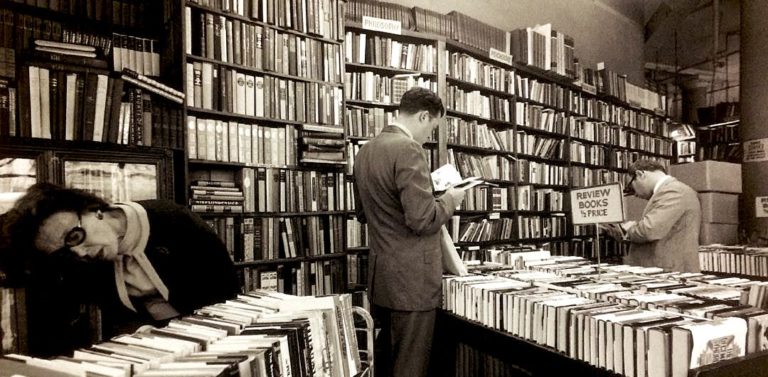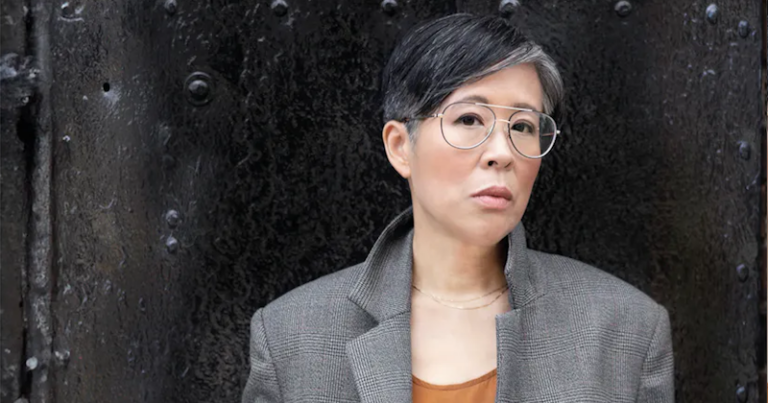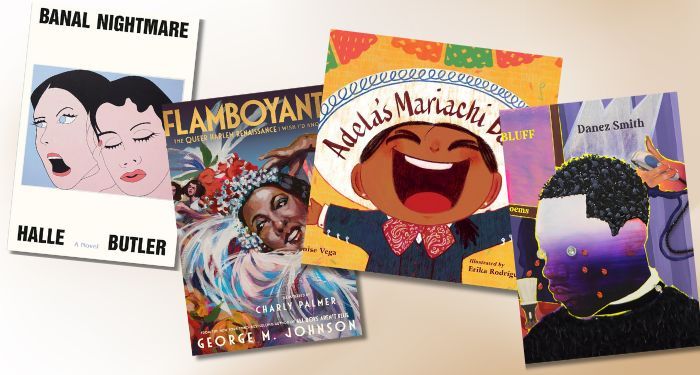By Peter Labilliere.

I enjoyed interviewing Samuella Mills whilst proceeding on a walk across Box Hill, having recently devoured The Watermark. It’s a strange, epic shaggy dog story about characters trapped in books who surf through narratives, with shades of Charlie Kaufman, Inception, Calvino, and Lewis Carroll. It was recently celebrated by the Irish Times as ‘A welcome slice of eccentricity’, with John Boyne praising it as ‘something different’ in ‘a world where replication, conventionality and formulaic writing are too often celebrated.’ Joanna Kavenna sums it up as ‘A thrilling and original novel: an existential mystery, a love story, an absurdist quest… A playful enquiry into ideas about freedom, fate, utopias, dystopias, AI, ethics and where truth might reside in a world of fakes’.
For me, it truly captures what a ‘topsy turvy’ place the world is…
3:AM: The Watermark is a playful and hyperactive book — in The Times, Simon Ings observes that it taps into the ‘madcap energy of Philip K Dick, at times’. What do you see as the source of that creative energy…?
SM: My father has schizophrenia, and his illness is the watermark in my work. It gives my writing its flavour, good or bad — the weirdness, the imagination, the manic energy; a preoccupation with the religious and the mystical, an excessive need to make connections, the everythingitis plaguing it.
In Fragments of My Father, I wrote about books and art that I think successfully represent the illness:
I’d found it hard to find fiction that captured my father’s condition. Given that the illness fractures the self into voices and hallucinations, how can a coherent first-person voice narrating a classically structured story with a beginning, middle and end, make any sense?
Simplistic tales about schizophrenia don’t tend to resonate with me. Art that captures its surreal, smashed psyche are the ones where I have an intuitive feeling of ‘Yes, that’s it! That’s what it’s like!’ Alice in Wonderland, with its strange dislocations of time and space and place — that is my dad’s illness. The modernist fragments of T. S. Eliot’s The Waste Land — ‘These fragments I have shored against my ruin’ — that is my dad’s illness. And Will Self, writing about a man who seeks to find patterns of meaning in the graffiti on toilets across London in The Quantity Theory of Insanity — that is my dad’s illness. I remember as a teenager sitting down and watching an episode of Monty Python, my mum laughing with me, my dad silent. The way it jumps from one mad scene to another, from a man holding a dead parrot, to the chorus of ‘The Lumberjack Song’, then back to something completely different — that is my dad’s illness.
(I would add to this list Utopia Avenue by David Mitchell, which I read recently; his depiction of schizophrenia in the novel is so good).
I am lucky to be in good mental health, to have transcended my Dad’s fate. However, I can feel quite vulnerable when my novels are published, because when people react to them as being bizarre or crazy — which is a perfectly reasonable response — I feel as if I am taken back to being a child again, when my Dad fell ill and did things like walking down the road naked, and we were seen as a ‘crazy’ family, suddenly ostracised by neighbours, schoolfriends. But I resist that anxiety: I want to keep on embracing the weird and wonderful in my writing…
3:AM: The Watermark begins with a villainous writer, Augustus Fate, who is suffering from writer’s block. He drugs and kidnaps a young journalist, Jaime, in order to infuse his consciousness into his novel and give life to his characterisation. Fate’s novel is set in the Victorian era: Oxford 1861, to be precise. Toby Litt (in his Guardian review) noted that ‘Here is where the novel is really clever — because it forces us to read extremely attentively. Each anachronism, everything that fits our world but not Victorian times, is a sign of Jaime’s genuine self struggling to break through.’ There comes a point where Jaime/Thomas ‘wakes up’ and regards the historical setting, Oxford 1861, as farcical, like a ‘Sunday night costume drama’.
SM: The first section works as thwarted, fucked up pastiche: free will versus fate played out in language.
I read a lot of Dickens when I was crafting this section: I would make lists of words and phrases and images to weave in. There’s a little of Dickens on nearly every page. Fate is definitely the sort of author who’d steal shamelessly; he borrows images such as ‘cheeks so red I feared birds might mistake them for cherries and peck at them’, phrases such as ‘sickly, spoony days’ and words like ‘visage’ and ‘benignant’ (a lovely, absurd sort of word — Dickens employs it in David Copperfield and Bleak House).
But it’s not traditional pastiche because Jaime is simmering beneath Fate’s creation. Fate wants to control Jaime, yet he also wants to harvest him, two desires he can’t reconcile. And so the language, the sentence structure, and so on, represents an uneasy tussle between Victorian and modern, between imposing narrator and rebellious author. Eventually, when Jaime does realise that he is a ‘real’ person who has been trapped in a novel, he still finds himself unable to entirely shake off the authorial style that Fate has imposed on him:
The last time I’d had Coca-Cola was when eating pizza with my mother, after she had attempted to cook a roast chicken, and had instead produced a black, smoking carcass; thus we had notified the local Pizza Hut of our request for several slices of their finest deep-pan.
And so even his memories of his ‘real’ existence, as they rush in, are flavoured by the man who has drugged him, a mash up of past and present.
Spontaneous human combustion was another Dickensian detail that was fun to weave in here. I like the moment in Bleak House where Mr Krook’s lodger enters to find a smouldering, suffocating vapour in the room and a dark, greasy coating on the walls and ceiling. Dickens wrote a preface where — defending himself against criticisms of sensationalism and giving currency to ‘vulgar error’ — he asserted that there were over thirty well-documented cases of spontaneous human combustion, including the famous death of Countess Cornelia de Baudi Cesenate. In The Watermark a local goes up in flames, a burnt severed leg remaining — the reader is left to speculate on whether Jaime introduces this into the story, or Fate, as with each book of the story: who is controlling the plot?
 Photo credit: Andrew Gallix
Photo credit: Andrew Gallix
3:AM: You began the novel in 2010 and finished during the pandemic — did you work on the book consistently over this decade?
SM: No, it was probably around 4 years of writing in total. I’m happiest when I’m working on multiple projects, writing something for a while, dropping it and letting it simmer in my subconscious, then circling back to it. The idea first sparked in 2010; I wrote the Prologue in late 2011, a few weeks before my Mum died of cancer on Christmas Day. Between 2012-2013, struggling with grief, I worked on a novel called The Economy of the Afterlife that never got published. In 2014, I began to work on The Watermark with full-time dedication: the Victorian section (The First Story), the Manchester Section (the Second Story), and the 2046 Section (the Fourth Story). Then 2016 came along and we’d set up Dodo Ink and I’d completely underestimated how much work running an indie press would be, plus my Dad had terrible catatonic breakdowns that year, so by its end I was felled with health problems and exhaustion and bedbound. In 2017 I wrote a draft of the Third Story. At the end of the year came my deal for a memoir, The Fragments of My Father, and I came back to The Watermark whenever there were gaps in edits. I ran out of money, was struggling with debts, but luckily The Royal Literary Fund gave me a generous grant. The Fifth Story was written in 2019, the Third in the pandemic (at one point this section was entirely in verse, but this version was discarded). Then I had a year where I needed to change agent, and then in 2022 it went out to 18 publishers and 17 rejected it and it was just down to Granta — and I was anxious that it wasn’t going to make it — and then I had to have a call with Anne Meadows, and later that day I went to see Batman and when I came out there was an offer in my inbox!
[A short break in the interview, whilst Peter Labiliere stood on his head for a little while, and then supped a cup of tea.]
3:AM: Jaime and Rachel — the two lovers in your book — surf through narratives, from a section set in an alternative Russian state in 1928, to an AI-dominated future in 2046. How does the concept of booksurfing work?
SM: Their travel from one narrative to another is employed slightly differently in each world, but it centres around a magical tea, Grand Kuding, which Fate has laced with herbs (inspired by the Welsh text the Meddygon Myddfai, a collection of medieval medicinal treatises), which dulls the characters into amnesia. Conversely, Soma tea (a nod to the Rigveda) wakes characters up.
A traditional fantasy novel tends to employ a strict set of rules that govern the created world, in order to anchor the reader. But I wanted to break the rules rule (!) and create something more slippery. My protagonists surf through worlds where there are often no clearcut rules — where characters speculate, attempt to assume authority or formulate theories only to find they collapse, fail to cohere or pan out. Their lives are — like ours — a braiding of knowledge and ignorance.
Mr Gwent is an example of this. He’s an eccentric character who was previously kidnapped by Fate and has been trapped in books for years. Initially, he appears as an advisory figure who is going to explain things. He suggests they find the Storyteller, a mythical figure who will help them find home, find peace — but, inevitably, they never do. Gwent also promises to give them free will in his narrative, set in Manchester 2011, only for their enchanted existence to collapse into dystopia, leaving them bewildered as to whether it is their fault or his.
In general, the narrators — the gods guiding the plot — leave characters lost and bewildered, representing the unknowability of life, the uncertainties of faith. It was an attempt to capture the way that life laughs at our attempts to impose neat meaning through stories, narratives, religion.
However, before this all sounds very theoretical — these ideas are explored, I hope, in a book that I wanted to be playful and pageturning. I always think of Calvino’s response to a 1985 survey, Who Do I Write? — “I consider that entertaining readers, or at least not boring them, is my first and binding social duty.” I think it’s good to entertain a reader, and permissible to irritate or confuse them, but never to bore them.
3:AM: There are dizzying jumps between narratives/worlds in the book, yet there is a unifying thread running through: a love story. The book works as an echo chamber, where certain phrases, tropes, events repeat or reconfigure. Rachel and Jaime, for example, keep meeting in a repeating scene where he approaches her carrying an injured bird; Beethoven’s Ode to Joy keeps playing in various stories.

SM: I see The Watermark as a midlife crisis novel. It was penned between my mid thirties and mid forties.
I wrote it lamenting the ignorance and freedom of my early twenties, when I was so confident and felt I could be anyone or achieve anything. Now, two decades on, I know too much.
I know all my flaws, can recognise recurring mistakes, bad habits, self-destructive patterns of behaviour. I once thought I was living a life that was the opposite of my parents’, but now I can see that I’m echoing their lives despite all my intentions.
I was also thinking about my mother as I wrote it: how she died at the age 65 feeling bitter and angry, because she had been trapped in a caring role for several decades, as well as a job she hated, and because she was too exhausted to fight her way out of it, she became preoccupied with luck and consulted astrologers as to what to do, consultations which reassured her but never changed anything. There are studies that show that depression is linked to the feeling that you suffer a lack of free will. So I came to the book thinking a lot about how much we do have the ability to shape our lives…
3:AM: My favourite section was the Third Story, set in an alternative Russian state called Carpathia in 1928. Jaime (Jaimus), once again incarnated as a musician, plays a yukuri: ‘A yukuri is half-animal, half-instrument, rather like a harp with a bird’s face protruding from one corner, and little claws that curl and pluck the strings. It cannot reach the soprano range alone, and so requires a human to accompany it’. I should very much like to own and play a yukuri. And a little later in this section, the two lovers turn into birds, where the book shifts into a graphic novel section, illustrated by Christiana Spens…
SM: Rachel (Raisa in this section) is being treated at a sort of hospital deep in the mountains, by Baba Slata, who gives her a therapy involving the linking of her consciousness to an animal:
To slip into the mind of an animal is рекуперативный: it connects you with nature, unifies, brings peace. In a primitive state, where decisions become instinctive, the intellect can stop scurrying — an overwrought mind can rest.
Rachel and Jaime opt to twin their minds with Russian waxwings, studying the birds obsessively for days until it ‘feels as though we are already avian, our human bodies heavy and clumsy, so that our desire to enter the waxwing’s light form seems less a foreign occupation and more a return to our true natures.’
 Illustrations by Christiana Spens
Illustrations by Christiana Spens
3:AM: A decade ago, you wrote a piece of journalism exploring the way that female cult fiction was treated, encouraging readers to discover Rachel Ingalls and Bridget Brophy who, at the time, had fallen into obscurity. How do you feel things have changed?
SM: Back in 2012-3, I would often go into bookshops to find that Cult Fiction displays would mostly contain only male writers (Burroughs, Bukowski, Hunter S. Thompson), and rarely female ones. I fell in love with Rachel Ingalls’ Mrs Caliban and the novels of Bridget Brophy, but to get hold of them you’d have to go on Amazon and seek out expensive second-hand editions. When I wrote the piece about cult female fiction, it went viral — the only time this has ever happened to me. In the last decade, there has been a dramatic shift in our attitudes towards female writing that is edgy, dark, or strange. Mrs Caliban is back in print and in bookshop displays, and I’m happy to see such progress.
3:AM: I’d like to ask more questions —
SM: I fear this interview is becoming longer than the book itself.
3:AM: Very well. I suggest we stroll down Box Hill now and enjoy the flitter and flutter of the butterflies around us.
SM: It’s been a pleasure being interviewed by you, Mr Labiliere — thank you.
ABOUT THE INTERVIEWER
Peter Labilliere is a gentleman who lives in a small cottage called The Hole In the Wall and regularly visits Box Hill to meditate. He is delighted to have been featured in The English Eccentrics by Edith Sitwell.












 Bengali (Bangladesh) ·
Bengali (Bangladesh) ·  English (United States) ·
English (United States) ·